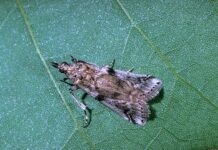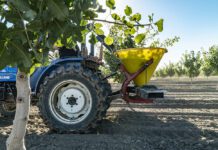
Some memories from the early days of my career as a California licensed PCA stand out among the rest. The first was feeling overwhelmed by the incredible number of crop protection products I needed to learn in the fruit and nut crops for which I was responsible. I doubted whether I could ever remember all the branded and generic products available. The second was feeling relieved that I would not have to use many of the potent, broad-spectrum chemicals of the past. As growers and PCA veterans recounted their pest management “war-stories”, many highlighted the dangers of those products that were no longer registered. As a young and idealistic PCA, I was glad to avoid the risks posed by those products, and felt confident in the plethora of integrated pest management (IPM) tools at my disposal.
Over the many seasons since, however, the continued loss of pesticide registrations and increased pest pressures have been alarming. Nut growers and PCAs are recognizing that many pest management programs, especially for certain insect and weed pests, are relying heavily on a few active ingredients (AIs) to achieve control in the field. Along with other IPM practices besides chemical control, growers are in need of new products to control pests and maintain their yield and quality goals. The new generation of crop protection products may look and function much differently from our current ones.
Greater Pressure on Fewer Products
Certain insects, diseases and weeds have become more difficult to control, which is not surprising given the expansion of tree nut production in California. Bearing almond acres, for example, have more than doubled in the last 20 years, according to USDA National Agricultural Statistics Services data (USDA/NASS, 2019). Along with more pistachios, walnuts and other crops, insect pests like navel orangeworm (NOW) have susceptible hosts from the southern San Joaquin through the Sacramento Valleys. Nearly contiguous production areas facilitate the movement of these pests, and at some point resistance as well.
The greater pest problems are accompanied by a reliance on a limited number of crop protection products. Regarding NOW sprays, Andre Alves, Strategic Account Manager for Corteva Agriscience, notes that, “Traditionally, pyrethroids were always used, but we know all the problems associated with those. So, there is a lot of pressure to move away from those, but that is putting more pressure on our really effective, selective insecticides.”
The problem we face is that even highly effective, environmentally-friendly products have a finite lifespan. UCCE Specialist Dr. Houston Wilson states, “It’s like any given chemical class; you have to use it smart, because eventually something is going to happen. There is no chemical that has lasted us forever; they are lost either because of regulation or the insect regulating through resistance, or the cost.”
Even with great IPM practices, there are still times when chemical treatment is necessary. The looming question is whether the industry will have enough treatment options to keep up with evolving pest populations, and satisfy consumer and regulator demands for safety.
Shifting from Conventional to Biological
This is where researchers and manufacturers have been focusing many of their efforts, including major commitments to developing biological products that combine commercial efficacy with environmental safety.
Dr. Surendra K. Dara, UCCE Advisor for Entomology and Biologicals says, “The focus of the pesticide industry is to develop chemistries that are less harmful to the environment, and do their job with minimal impact on non-target organisms and the environment, while ensuring human safety as well.”
Manufacturers have dedicated hundreds of millions of dollars in recent years to partnerships, acquisitions and building out research and development capacity around biological products.
One of the biggest challenges around biological products, which can include a wide
variety of biologically or naturally derived active ingredients, is a lack of confidence that
the products can perform to commercial production standards. Some people may also equate biological products with Certified Organic products, which is not necessarily the case. Dara has observed this from growers and PCAs.
“There is a skepticism about the efficacy of biologicals that everyone is aware of,” Dara said. “At the same time, there is skepticism of conventional pesticides, too. There are several chemical pesticides that give inconsistent results. But they do not question the efficacy, because it is a conventional pesticide. But when it comes to biological pesticides, it may not work. That perception has to change first.”
Building Experience and Confidence
New products on the market may be able to accomplish that perception change. Spear-Lep, for example, is a peptide-based biological insecticide manufactured by the Vestaron Corporation. It is registered for use on labeled tree nuts, and Technical Sales Representative Noel Cornejo shared that trial data suggest comparable activity to conventional products available for NOW control. If manufacturers are able to develop and release cost-effective biologicals with excellent crop safety profiles, new modes of action and independently-tested efficacy data, growers and PCAs are likely to try the products. The adoption of spinosyns and even some biofungicides recently has proven the willingness of many growers to change to new tools.
But growers and PCAs also need to understand the unique requirements for handling and applying some biological products, especially those with live organisms. Dara advises, “Knowing what the biopesticide is and how to handle it is very important knowledge for growers and PCAs, so they can use them effectively.” Heat sensitivity in storage, or tank mix compatibility issues could result in reduced efficacy or failure if correct procedures are not followed. Just like conventional products in use, correct handling, mixing and application procedures are critical to efficacy.
Developing and Leveraging Other IPM Tools
Even the most effective conventional and biological pesticides should not be relied upon alone to manage pest issues.
“Integrated pest management has been around for a long time,” says Dara, “and chemical control as a last option has always been emphasized. But even now everybody looks at pest management, and thinks it is about which pesticide they use.”
That approach not only increases the risk of developing resistance in pest populations, but it may also prove to be insufficient at keeping crop damage below an economic threshold. Most effective pest management programs require a combination of cultural practices, monitoring, biological control and chemical applications.
As new biological crop protection products are developed and commercialized, there is still a need to develop and adopt new IPM practices to effectively manage pests. Improved weather and pest monitoring can result in better application timing and improved control. Managing water and nutrients may be even more critical than preventative fungicides for certain fungal pathogens. By combining these practices with new, safer modes of action, growers and PCAs will be equipped to ensure the long-term sustainability of tree nuts in California.











